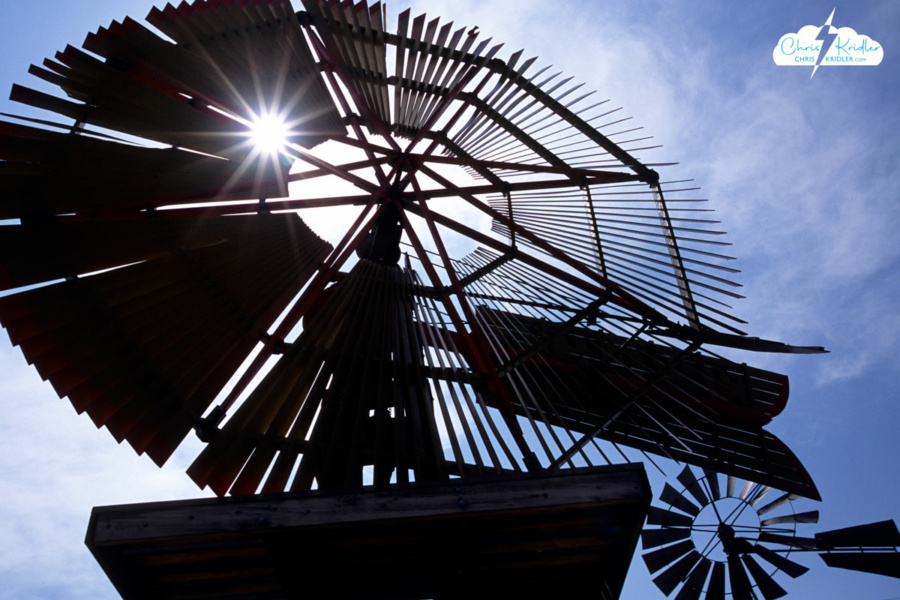
Atmospherics at the windmill park at Shattuck, Oklahoma, on May 23, 2002.
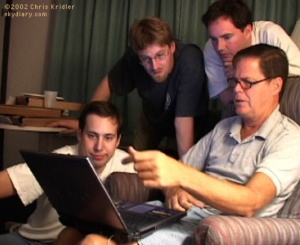
Chasers (from left) Dave Lewison, Mark Robinson and Bill Hark looked over Jim Leonard’s shoulder as he checked data on the Internet on May 19, 2002.
I have extensive archives from my early storm chasing years. I chronicled almost every day on the road, even bust days, at the old SkyDiary site, with lots of photos. In the interest of collecting everything in one place, I’m moving the highlights of the older chases – or quirky moments worth remembering – over to ChrisKridler.com. With that in mind, this post collects just a few of the accounts from 2002 and select photos to accompany them.
May 21: North Platte, Nebraska
After one real chase on a really weak storm day, I’m exhausted. There’s been way too much driving and pizza over the past few days. But at least we were chasing today, despite marginal chances and marginal storms.
The first couple of days of the trip were spent sitting around in Norman, Okla., watching storm video with other chasers, reading technical manuals so I can learn to work my gadgets, and duct-taping things, including the toy Power Ranger on the front of my car (this is his third chase season).
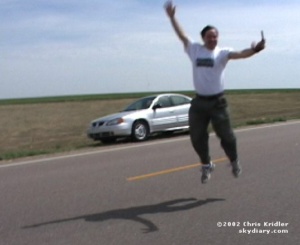
The weather pattern has been rotten – one forecaster says it’s the worst for storms since 1987. Early in the month, when I wasn’t here, there was a great week, and then it all went to hell. Well, finally, a big storm system is pushing out the high pressure, but the moisture hasn’t yet returned from the Gulf of Mexico, and without moisture, there are no decent storms.
I’m chasing with Dave Lewison of New York state and Bill Hark of Richmond, Va. We’ve seen lots of tacky Americana so far, including the big Indian at the Cherokee Trading Post in Oklahoma and the giant Van Gogh sunflower painting in Goodland, Kansas, a hub of the sunflower industry. It sits on a giant easel in a dusty vacant lot and is about the size of a billboard, only vertical.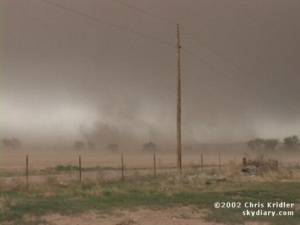
Today we headed northwest out of Goodland toward our target area in eastern Wyoming. Every time we stopped to take a reading, the anemometers showed higher and higher winds – 20s, 30s, 40s, 50-plus miles per hour. It was difficult to stand against it. Our clothes whipped around us, and the car was hard to handle as gusts pushed it all over the road.
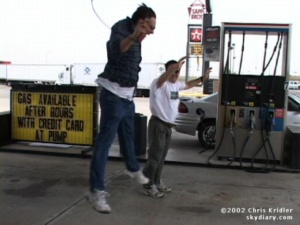
And then there was the dust. Everywhere, it poured off the fields and into the air, streaming across the road, creating a choking haze of fine silt that got into everything – our hair, ears, eyes, cameras, car, clothes. The fierce winds punctuated each gust of dust with skittering tumbleweeds that seemed to float on the fields of wheat, bouncing across the waves, and then lofting across the road, sometimes nailing the cars in the process. The Dust Bowl must have been something like this.
By the time we got into eastern Wyoming, we’d had data and phone calls from friends and fellow chasers who told us what we didn’t want to hear: There were storms where we were headed, but they were weak. On top of that, they were almost impossible to see.
We decided to intercept one. After all, we’d driven all the way to Wyoming. We were in mountain time and everything.
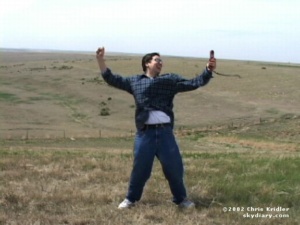
At last, a storm loomed out of the haze, a great, mushy monster trailing virga – rain that wasn’t hitting the ground – and the raggedy edges we call scud clouds. It was linear, not spinning, part of a long line of storms that had formed a gust front, pushing walls of dust in front of it.
We played tag with the storm, watching it spin up gustnadoes – weak tornado-like spinups on the edge of the gust front – and even being hit by some. One piece of debris took out one of my antennas. We stopped briefly to put it back up. Another peppered us with tumbleweeds.
After yet another pizza dinner with some chasers from Arkansas and south Florida, we enjoyed a lightning show while driving an enormous number of miles, still being buffeted by fierce winds. We’re in position to head east tomorrow for more chasing – and, we hope, better chasing.
May 30: Norman, Oklahoma
It’s been nine days since I’ve sent an update. This will be a more succinct summary, I hope, especially since there hasn’t been all that much fantastic weather to talk about. We’ve been driving all over creation, with not much to show for it.
On May 22, Dave Lewison of New York state, Bill Hark of Richmond, Va., and I ended up chasing storms that quickly evolved into a messy line, a story that was to repeat itself far too often. Yet, in Smith Center, Kansas, the tornado sirens went off and we saw what looked like a healthy wall cloud on the storm. We got out of the way of the supposed tornado – or tornadic circulation – but didn’t see anything too impressive.
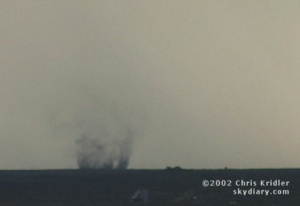
May 23 was much better – in fact, the best chase day so far. We began the day with some good, old-fashioned Americana, the world’s largest hand-dug well in Greensburg, Kansas. Underground, there are stairs and platforms, several feet across. You can look in from ground level, outside the de rigueur gift shop. There was a honkin’ big tornado siren on top of the water tower right next to the well, and I hoped that would bode well for later in the day. The water tower was labeled, helpfully, “BIG WELL.”
By the time we checked data, we had just about given up hope. The atmosphere seemed contaminated by ongoing storms, cold and cloudy. But Bill got information after lunch that the atmosphere was clearing to the west, so we decided to play the dryline in the Texas panhandle.
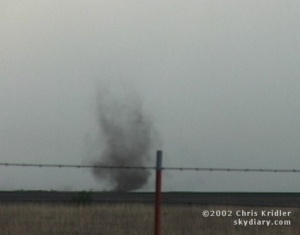 On our way to the border, we stopped in Shattuck, Okla., where a mesmerizing park sprouts a number of old-time windmills, in a variety of designs. Every time the wind blows, there’s a haunting creaking and whispering from these beautiful mechanical trees, giant metal flowers that tower above the colorful wildflowers at their feet.
On our way to the border, we stopped in Shattuck, Okla., where a mesmerizing park sprouts a number of old-time windmills, in a variety of designs. Every time the wind blows, there’s a haunting creaking and whispering from these beautiful mechanical trees, giant metal flowers that tower above the colorful wildflowers at their feet.
We noticed cloud towers starting to go up, so we broke off our tourist stop to head west. Over the border and into Texas, we waited, seeing other chasers as we went, watching the towers climb and topple until, finally, they broke through the cap. The explosion of convection was what we were waiting for, and we headed toward the storm.
It was very high-based, thanks to the lack of moisture in the air, but it was rotating. To our surprise, it put down a dusty little tornado (landspout?). As we followed it, it put down about three more (pictured). At one point, we were literally across the road from the main area of rotation as it majestically spun itself into a large, sideways funnel shape and spun apart again, not quite ready to do it. Soon after that, the storm began to die.
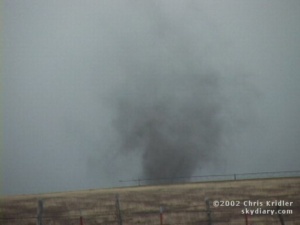
We were hearing reports from nowcaster Jason Politte, an Arkansas storm chaser, of a much better storm near Borger, Texas, west of Pampa. The hitch: I had to be in Oklahoma City the next morning to play airport taxi. I reluctantly agreed to go after the storm.
On the way, we saw another storm that suddenly looked very impressive, with a wall cloud that looked like it was about to put down a tornado. Indeed, it did put one down briefly, as fellow chaser Scott Blair captured on videotape … though we couldn’t really see it. As the sun set, we left that storm and headed toward the Pampa one. Once we saw it, I had no doubt we had made the right decision. It was a beautifully sculpted storm; my one regret is that there wasn’t much light left to enjoy it. In fact, Bill captured a tornado under it using the low-light setting on his video camera, but it wasn’t visible to the naked eye.
The storm was sucking in 40-mile-per-hour inflow and spitting out amazing lightning. We watched it for some time, snapping pictures, before giving in to the late hour, a quick meal and a marathon drive back to Oklahoma City.
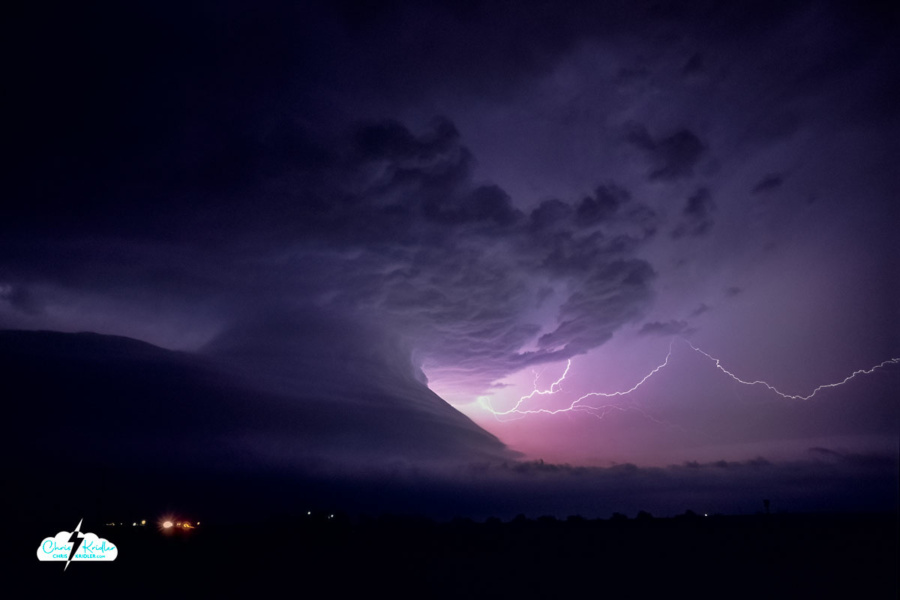
The storm near Borger and west of Pampa, Texas, had a significant wall cloud. The storm assumed an amazing structure as darkness fell as it spat out lightning.
The next morning, I picked up George Jenkins at the OKC airport. He’d never been chasing before, and I was hoping to show him some “good” weather – better than what we were used to in Florida – but the pattern still wasn’t all that cooperative. On May 24, our hopes for isolated supercells were dashed as messy storms again exploded all over the Texas panhandle and eastward. We briefly chased a storm with a tornado warning on it, then found out a short tornado occurred on another storm near the town where we were staying the night. The only thing that redeemed the chase was a pretty sunset and some pouchy mammatus clouds lit orange in the twilight.
The next day, we played tourist, exploring the magnificent Palo Duro Canyon south of Amarillo and eating steak with other storm chasers at the Big Texan that night, then watching each other’s video. Some of it was Scott Blair’s latest encounter with hail. Since he was with Dave and I during the trashing of my car during a hailstorm last spring, he’s been determined to take his core-punching to the limit. A couple of days later, he would smash his windshield further by driving into spiky, baseball-size hailstones.
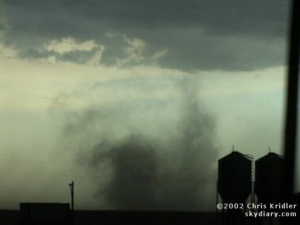
May 26 brought several possible target areas. We decided to play the area where the dryline was pushing into the Oklahoma panhandle and southwest Kansas, but soon after we got on the storms coming out of southeast Colorado into the Oklahoma panhandle, it was the beginning of the end of our supercell hopes. The storm was filled with the green light that often indicates hail, and its forward edge started roiling. We realized it was gusting out, or becoming an outflow-dominant storm. In other words, it would not be a sustained supercell, but a blowout with high, unidirectional winds.
We kept up with it as it kicked up massive plumes of dust and saw some fantastic gustnadoes – tornado-like circulations that often form on the edge of a storm. Some of the gustnadoes looked meatier than the tornadoes we saw a few days before. Huge, rotating bowls of dust formed on the desolate plain. One gustnado crossed the road right in front of us as tumbleweeds bounced past.
W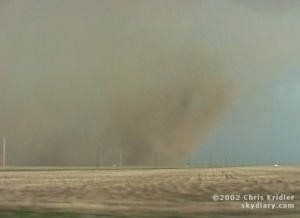 e were feeling cold outflow winds the whole time, and then, briefly, we got warm inflow, the sign that at least one part of the storm was still trying to stay alive by pulling in warm air from the east. About that time, a huge gustnado – could it have been a tornado? – spun up red dust in the field right next to us. The dust churned and rose, almost in a tube shape, to the edge of the storm clouds.
e were feeling cold outflow winds the whole time, and then, briefly, we got warm inflow, the sign that at least one part of the storm was still trying to stay alive by pulling in warm air from the east. About that time, a huge gustnado – could it have been a tornado? – spun up red dust in the field right next to us. The dust churned and rose, almost in a tube shape, to the edge of the storm clouds.
I had to split off from Dave for a day so I could take George back to the OKC airport. I was sad to see George go and also sad not to chase, but in keeping with the pattern, I didn’t miss all that much, stormwise. I was in a melancholy mood when I got to Abilene that night and met up with Dave, Bill and Jason Persoff of Jacksonville, Fla.
The four of us ended up chasing way into south Texas on May 28, maybe 50 miles from the Mexican border, and all for storms that were struggling to stay alive – though the lightning got incredibly hot and close at one point. To top things off, I hit a deer with my car – a glancing blow, but I’m sure the deer didn’t think of it that way. It shook me up as well. Fortunately, it hit the hail-dented side of my car, so it’s hard to notice the impact.
After sunset, our last storm began to weaken, but its snowy updraft – where the billowing clouds grew to meet the sky – spit out lightning as dusk fell. We ended the night joking around and looking at fireflies and the canopy of stars on the side of a rarely traveled road, among the mountains and mesas, where no artificial light polluted our view.
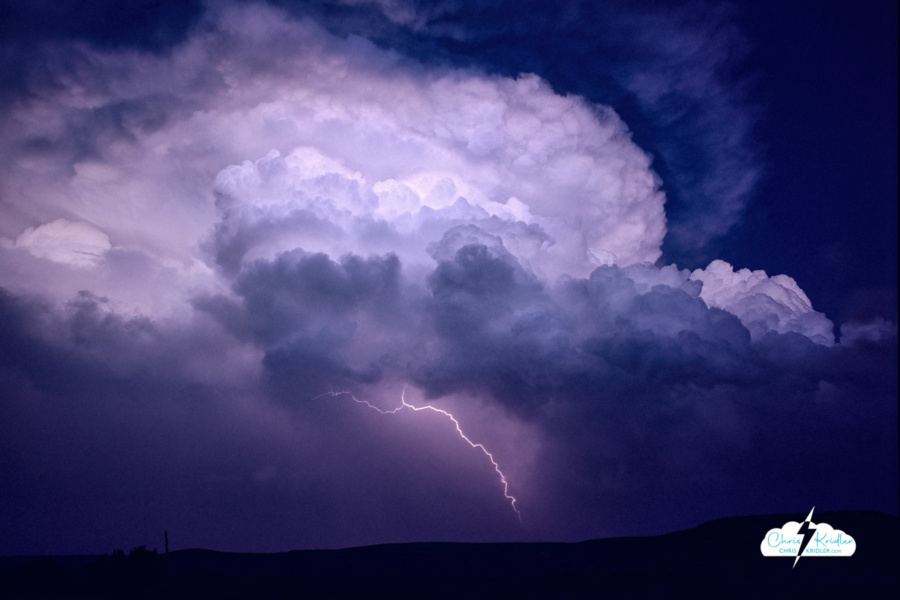
The storms were weak, but the universe is still spectacular. Even if we did have to eat a burger at midnight on the Interstate at Fort Stockton or go to bed hungry.
Since then it’s been goodbyes and relaxed traveling under sunny skies, hoping for the next storm system. Dave and I saw some bison today at the Wichita Mountains National Wildlife Refuge, relics of a past when there were 60 million of them roaming the Plains. Tonight, we joined the Cloud 9 Tours folks for dinner in Oklahoma City and saw the International Space Station go by overhead, a tiny dot of light. Later, a few of us went to a spot east of Norman where we could see an Iridium satellite flare at the precise time it went over our location, reflecting sunlight for one lovely moment in the dark sky.
I have another week of chasing ahead. At least, I hope it’s chasing … and not more suntan.
June 5: Paducah, Texas
This is only my third and probably my last bulletin of this year’s low-key chase in the Plains. The only big events were before I arrived, but I’m sure there will be another big one after I go home.
Still, I got to see a few fun storms, the kind I would never see in Florida, and that’s why I’m out here. I also had a couple of close encounters with hail that convinced me I’m not quite over last year’s hail attack – the one that really messed up my car. Post-hail stress syndrome. I now have some dents on the “good” side, too, but they’re more subtle.
I had a couple of down days since I last wrote. On June 1, I went to the storm-chaser party at Rocky Rascovich’s house northwest of Oklahoma City, which was fun – the usual mix of burgers and amazing storm video. The highlight (admittedly, I left early so I could do another marathon drive) was Tim Marshall’s footage of the Happy, Texas, tornado in early May. In his footage of this monster, you can see the twister ripping roofs off.
Then Scott Blair from Arkansas and I drove our cars all the way to Kearney, Nebraska, to meet up with Jason Politte, also from Arkansas. The idea was to get into position for a chase the next day, which took us up into northeast Nebraska. Though there was a small cap – the warm layer of air that can keep storms from going up – we were optimistic that if a storm did occur, it would be a monster.
The only outbreak we got was of horseshoe vortices, the little horseshoe-shaped clouds that show there’s shear in the air. And I learned to play ground curling, a game Scott & Co. have played in the dirt on roadsides while waiting for storms. It’s a little like horseshoes, but more complicated. Usually you roll rocks, but road debris was permitted. I used a most excellent giant bolt.
After that, we had to drive some more – this time to western Nebraska, to get into position for the next day’s chase in eastern Colorado.
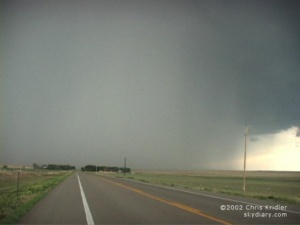
Hail core on June 3.
June 3 we left North Platte, Nebraska, under the grungy, cloudy skies north of the cold front to head for Colorado. We decided to check computer data in Last Chance, where we got a snack at the Dairy King. The Dairy King is about the only thing in Last Chance, which is in the middle of some of the most desolately beautiful, empty country you’re likely to see.
After I ate some fries, I went to my car to get my computer and came back in fast. “Initiation has occurred,” I said. And how. It was a big supercell with a crisp anvil to our southwest. Jason pulled up some data on his computer with a cell modem, and I did so inside the eatery … it turns out there was already a radar-indicated tornado warning on the cell.
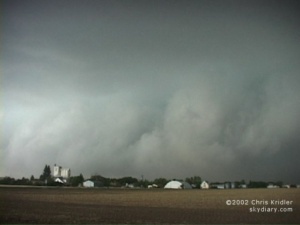
We headed onto some somewhat challenging dirt farm roads to get a better look at the burgeoning storm. It was attempting to form a wall cloud, and it already had pouchy mammatus clouds. We realized we’d have to get south to Limon and get gas fast if we wanted to stay ahead of the core, which clearly had some meaty hail in it.
We hauled butt south to beat the hail core – a high-adrenaline, somewhat scary drive – and as we filled up at a gas station we were blasted with wind, rain and dust as the storm began to move in. We got east on I-70 just in time and got ahead of this increasingly impressive storm.
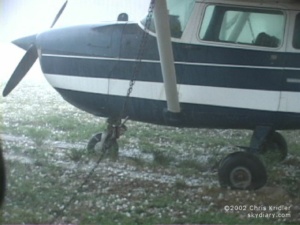
We pulled off the interstate at Arriba, where Scott and Jason decided to go north on a farm road. I hung back, since I had a good view – and didn’t want to get that close to the hail. Charles Edwards, Jim Leonard, John Guyton and their Cloud 9 Tours folks pulled up in a few minutes, saying they’d narrowly escaped baseball- and softball-size hail, and we all watched as the storm rolled in, appearing as a massive, toothy gust front. It still had a tornado warning, but the area of rotation was not holding together very well.
Scott and Jason soon returned from their foray north, but as they tried to find hail shelter among slim pickings at Arriba, I decided to go a little further east and try my luck. In Flagler, I found the perfect thing: a tiny airport with carport-like, tin overhangs to house airplanes. I got into an empty one and waited, watching the storm’s mesocyclone start to look impressive. But I didn’t want to go after it; I wanted the hail.
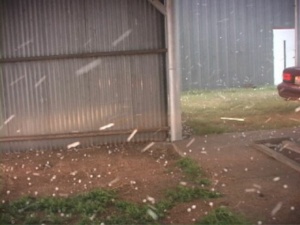
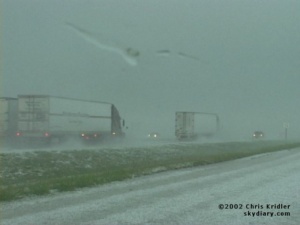
I managed to contact Scott and Jason, and they happened upon me just as the storm began moving in. They barely got under the overhang as buckets of golf-ball-size hail began to drop from the sky, bouncing high and banging like gunfire on the tin roof. The noise was incredible, and the ground was soon covered. It was suddenly a winter wonderland.
The guys left a few minutes before I did. I decided to make my way down the interstate access road, which, like the interstate, was slick with hail. The land was covered in white, and hail fog seriously limited visibility. By the time I caught up with Jason and Scott again near the Kansas border, the meso was gone, and the storm had weakened considerably.
We headed south to Liberal, Kansas, to get into position for June 4. We picked a target around Lubbock, but storms were going up everywhere on the front as we moved south. We separated again as they chose to go first through some hail that I went through a few minutes later, and once I got out of the core, I found myself facing a storm, just to my south, with a distinctly rotating mesocyclone. A tornado warning had been issued, and I was sure this would be it. This would be the storm that would produce the big one. It appeared to have a wicked rear-flank downdraft kicking up dust, and I paralleled it east on a ranch road as it sucked in huge amounts of brown dust from the farmers’ fields.
When I got close to it, north of Idalou, I saw what I didn’t want to see – a little outflow, showing the storm was teetering. And then – tornado on the ground! Ooops. Actually, I soon realized, it was probably a gustnado, a tornado-like spinup on the leading edge of the storm, which was starting to gust out. For a few moments, it was chaotic – several fast vortices were on the ground at once, and I almost thought I had a developing tornado on my hands. But no … after filming a few impressive, persistent gustnadoes, I again met up with Scott and Jason. They had had a great view from the south of the meso with rotating swaths of dust under it.
We were about to give up on the day when one of the linear storms began to reorganize. Dave Lewison, nowcasting from home, alerted us that it might have a meso, and once we got closer, we saw it had a beautiful structure. And hail. The white curtains of hail were wrapping around the meso, which was moving east as we drove north … it was a lot like our May 30 hail encounter of last year, the one that trashed my car. “Not again!” I kept saying.
Scott was in the lead and warned us that we needed to beat it, but there was no way to do so. When the first golf balls fell, I bailed almost immediately after spotting another perfect hail shelter south of Floydada, a cotton gin with an open, high tin roof. More loud hail! There were a few golf balls, but most stones were quarter-size, and after a few minutes, I proceeded east. I got into some more hard hail, but it was small. When I got ahead of the storm, I was treated to some intense lightning. But then I got into the Caprock area, full of canyons and hills, and very low clouds began to obscure all visibility. When Scott and Jason caught up with me, we headed northeast some more, but the storm had weakened, and our chase was pretty much over.
We had a good dinner at Billie Dean’s Cafe in Matador, a great little place that’s been around for decades, then decided to hunt some lightning. Dave told us that one storm was dropping 3-inch hail. Scott, hail magnet that he is, decided he wanted to go into it. After all, most of his lights are broken, and his windshield has more cracks than the sidewalks of New York.
Jason and I got into perfect shelter under a car wash, which guaranteed that we wouldn’t get the hail core. Still, as we watched the storm approach our location in Dickens – and slip slightly north – the lightning and the sound of the wind in the wires was eerie. At times, the sound was like music, a keening wooden flute in the darkness.
Scott emerged from the core, saying, “You do not want to (mess) with this storm.” Only, he didn’t say “mess.” His car was further damaged, and the chase was over – we made it to a funky hotel in Paducah, Texas, before giving in to exhaustion.
July 23 and 25, 2002: Triggered lightning at Camp Blanding, Florida
At Camp Blanding, Florida, the University of Florida has a lightning research facility. There, triggered lightning is used in a variety of experiments. Small rockets are launched from tubes at the top of a tower during a storm, building up positive charge as they zoom upward and attract lightning. A trailing copper-Kevlar wire guides lightning to the ground. The wire is vaporized and return strokes resemble natural lightning enough to be used for research.
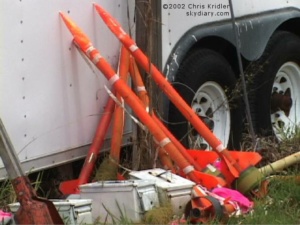
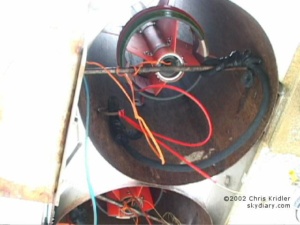
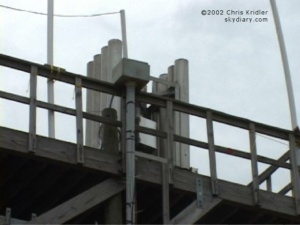
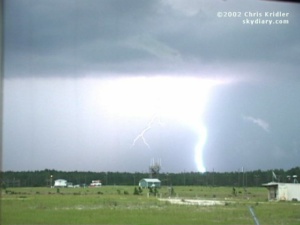
My visit on July 23 on an assignment for my newspaper produced no storms, so lightning couldn’t be triggered. Two days later, a good storm came over the site. The first lightning image is natural lightning, before triggering began.
When the negative electric field reaches the right strength, the guys in the launch trailer next to the tower press the fire button.
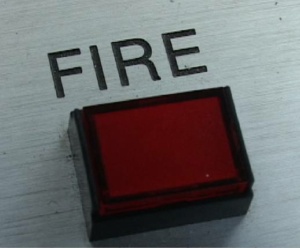
Here’s a succession of bolts after the rocket is launched. Note that the first bolt goes below the tower as it vaporizes the wire. The rest are return strokes. Images from video.
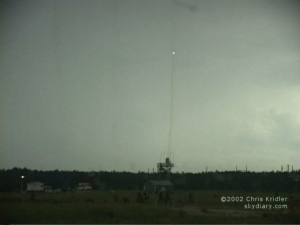
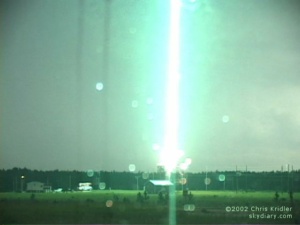
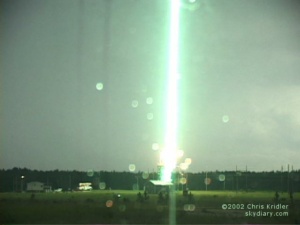
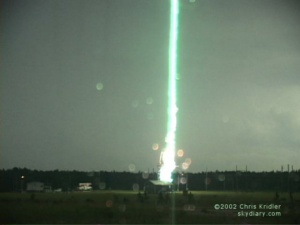
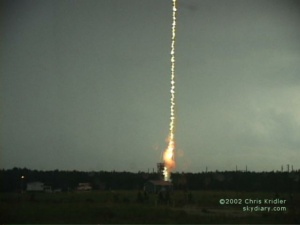
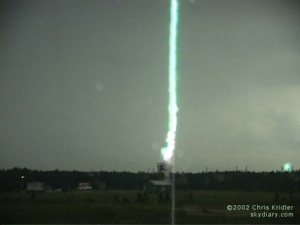
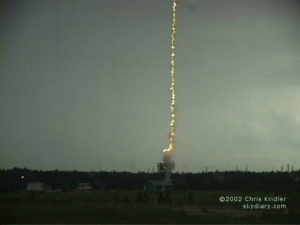
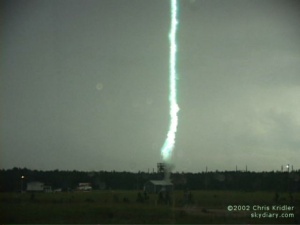
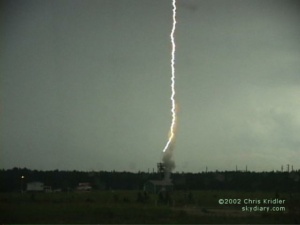
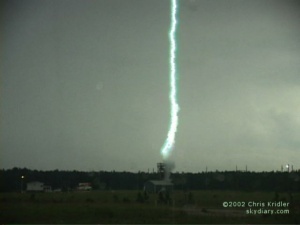
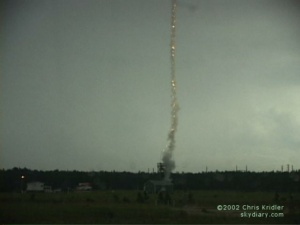

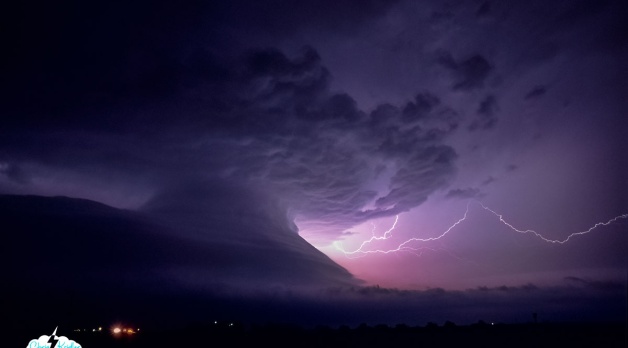
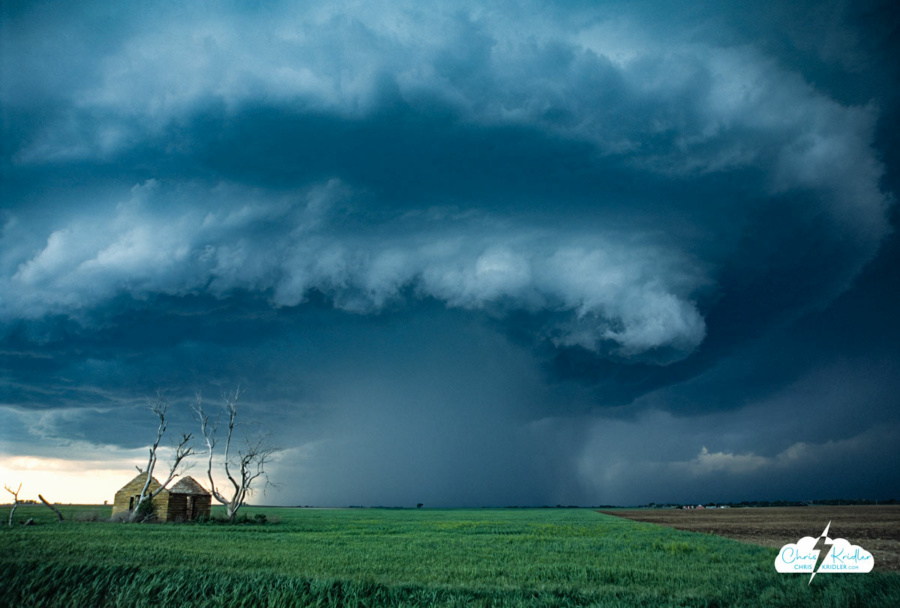
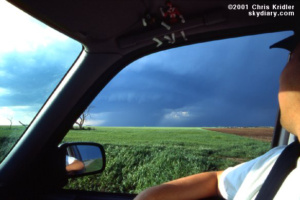
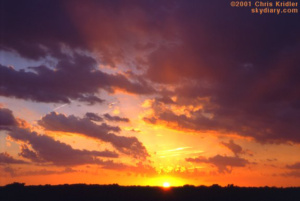
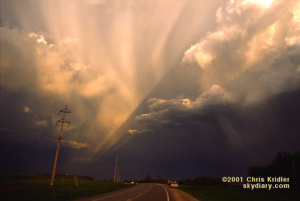
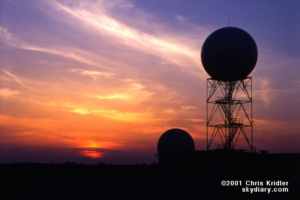
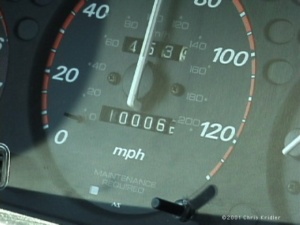 I last wrote on May 15. On May 16, we chased with George in Kansas, but didn’t see much … just some mushy storms and a few lightning bolts. And my car’s odometer turned over 100,000 miles somewhere near Liberal, Kansas.
I last wrote on May 15. On May 16, we chased with George in Kansas, but didn’t see much … just some mushy storms and a few lightning bolts. And my car’s odometer turned over 100,000 miles somewhere near Liberal, Kansas.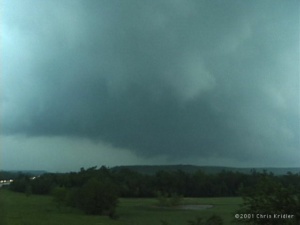 After a brief lightning show at our hotel in Denison, Texas, we got a little sleep and got psyched for Sunday, May 20. The Storm Prediction Center’s discussions of the day’s potential included all kinds of signs of doom, and the other data seemed to bear out the potential for tornadoes. We hovered on the Texas-Oklahoma border at a truck stop, checking data on the laptop, then headed into Oklahoma to Atoka in the early afternoon to get nearer to where the action was, in the PDS tornado watch box – or “particularly dangerous situation.” A quick Internet radar check revealed a couple of storms had already gone up north of us, on the boundary. We started heading that way.
After a brief lightning show at our hotel in Denison, Texas, we got a little sleep and got psyched for Sunday, May 20. The Storm Prediction Center’s discussions of the day’s potential included all kinds of signs of doom, and the other data seemed to bear out the potential for tornadoes. We hovered on the Texas-Oklahoma border at a truck stop, checking data on the laptop, then headed into Oklahoma to Atoka in the early afternoon to get nearer to where the action was, in the PDS tornado watch box – or “particularly dangerous situation.” A quick Internet radar check revealed a couple of storms had already gone up north of us, on the boundary. We started heading that way.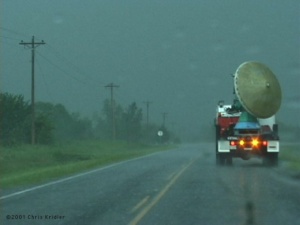 Ahead of us on Route 75 were two Doppler on Wheels trucks. We took this as a good sign, but the circumstances were not good. Chasing in eastern Oklahoma is challenging, to say the least. There are massive hills and lots of trees. It’s very difficult to see storm structure. And rain makes it even worse, and boy, did we get rain – but not yet.
Ahead of us on Route 75 were two Doppler on Wheels trucks. We took this as a good sign, but the circumstances were not good. Chasing in eastern Oklahoma is challenging, to say the least. There are massive hills and lots of trees. It’s very difficult to see storm structure. And rain makes it even worse, and boy, did we get rain – but not yet.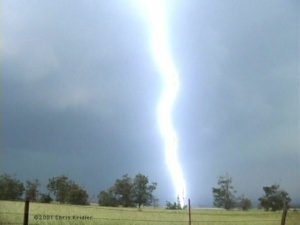
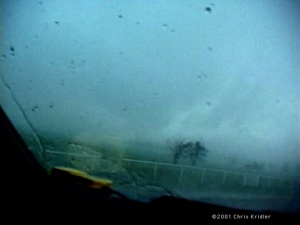 Certainly, we were in a tornadic circulation, if not just south of a tornado, and my adrenaline was high. It’s the first time I ever felt truly in danger from a storm. In town, the sirens were screaming. Some guy was poking along ahead of me as if he was out shopping for flowers. I flashed my lights and he moved over. At a red light, I stopped, made sure no cars were coming, then went through with my blinkers on. Dave was aghast. I said, “It’s a #&%*$ tornado, Dave, I’m running the red light!” As we pushed through town, rain curtains ahead of us were clearly rushing from right to left, wrapping around the area of rotation. We were in the “bear’s cage,” no doubt about it.
Certainly, we were in a tornadic circulation, if not just south of a tornado, and my adrenaline was high. It’s the first time I ever felt truly in danger from a storm. In town, the sirens were screaming. Some guy was poking along ahead of me as if he was out shopping for flowers. I flashed my lights and he moved over. At a red light, I stopped, made sure no cars were coming, then went through with my blinkers on. Dave was aghast. I said, “It’s a #&%*$ tornado, Dave, I’m running the red light!” As we pushed through town, rain curtains ahead of us were clearly rushing from right to left, wrapping around the area of rotation. We were in the “bear’s cage,” no doubt about it.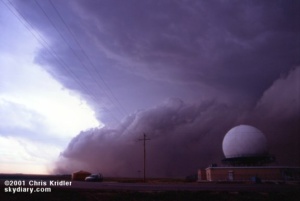 May 27 was a blast, or, you might say, a sandblast. Dave, Bill and I met up with Steve Sponsler and headed up into Kansas. We had hopes for supercells, but most storms were going up early and beginning to merge in a messy line. At a truck stop in Sublette, we looked at radar images and weighed our options as the sky outside became more and more ominous. By the time we headed north, it was too late to get individual cells … the whole mess had merged into a great line, a dramatic shelf cloud rolling toward us, kicking up brown dirt underneath it as it went. We stopped by a radar dome and got video and stills as it approached. Then the first dust hit. It was a haboob, a Dust Bowl storm, a roaring animal.
May 27 was a blast, or, you might say, a sandblast. Dave, Bill and I met up with Steve Sponsler and headed up into Kansas. We had hopes for supercells, but most storms were going up early and beginning to merge in a messy line. At a truck stop in Sublette, we looked at radar images and weighed our options as the sky outside became more and more ominous. By the time we headed north, it was too late to get individual cells … the whole mess had merged into a great line, a dramatic shelf cloud rolling toward us, kicking up brown dirt underneath it as it went. We stopped by a radar dome and got video and stills as it approached. Then the first dust hit. It was a haboob, a Dust Bowl storm, a roaring animal.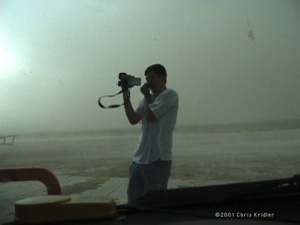
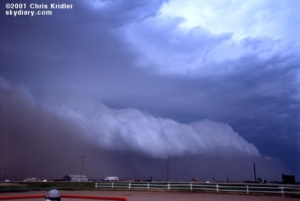
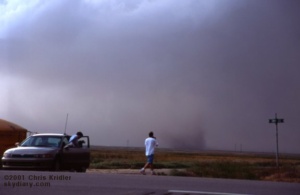
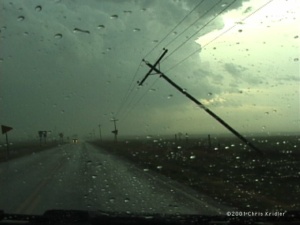
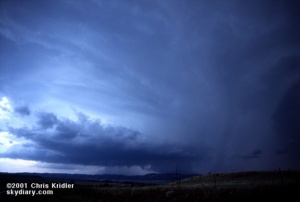 Upslope storms – the kind that form on the higher elevations near the mountains – seemed the best bet for May 28. The phones were out in the hotel, which was a very plush Super 8, I might add, so we got the basics on the day’s outlook from Jay Antle and began meandering west. We met up with Ed Roberts from Kansas City and some other chasers in Guymon, Oklahoma, who kindly shared some data files they’d pulled, and we headed farther west. In Dalhart, Texas, a nice woman at the Holiday Inn Express let us plug in for a few minutes to get more information, and we headed for Clayton, New Mexico. If you’re counting, that’s three states already.
Upslope storms – the kind that form on the higher elevations near the mountains – seemed the best bet for May 28. The phones were out in the hotel, which was a very plush Super 8, I might add, so we got the basics on the day’s outlook from Jay Antle and began meandering west. We met up with Ed Roberts from Kansas City and some other chasers in Guymon, Oklahoma, who kindly shared some data files they’d pulled, and we headed farther west. In Dalhart, Texas, a nice woman at the Holiday Inn Express let us plug in for a few minutes to get more information, and we headed for Clayton, New Mexico. If you’re counting, that’s three states already.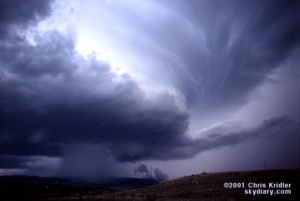
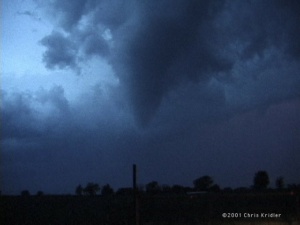
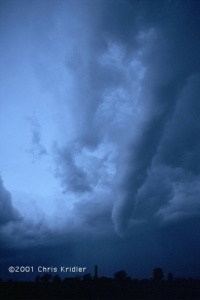
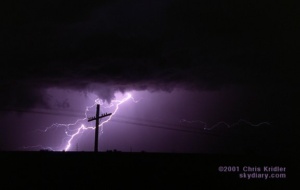
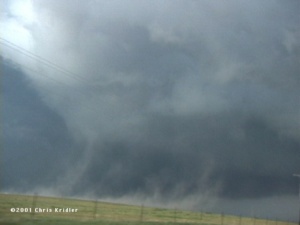
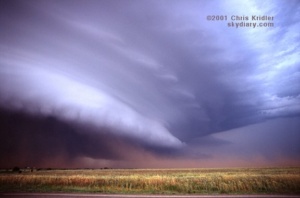
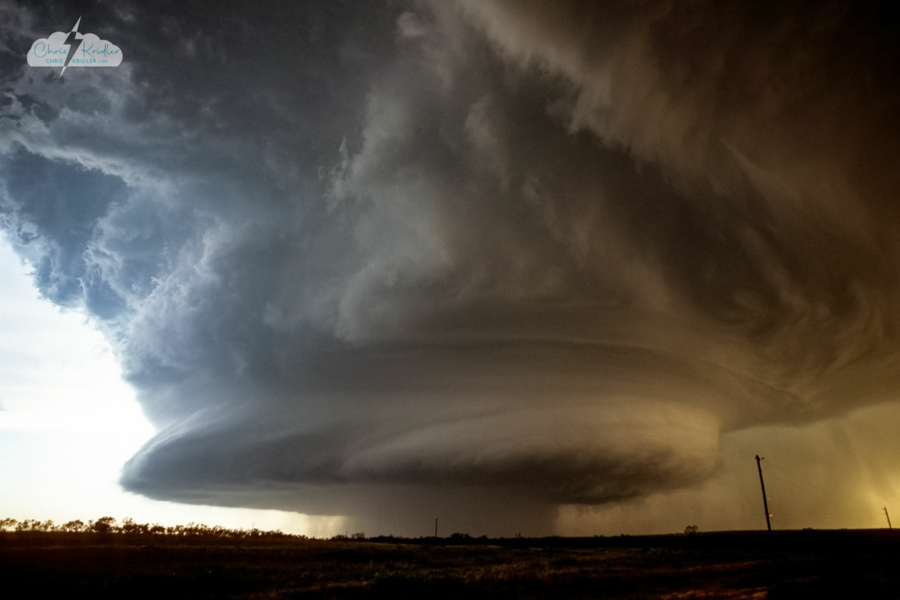
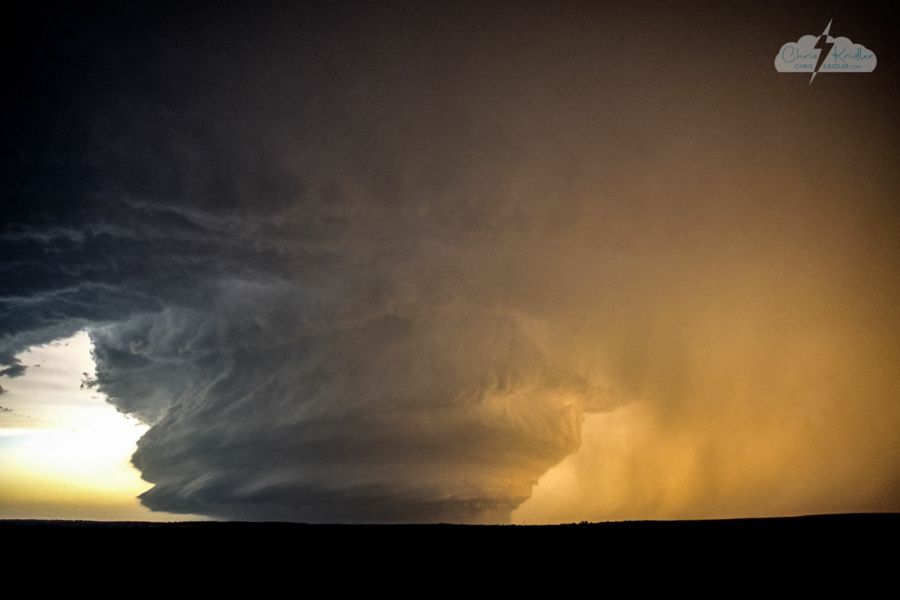
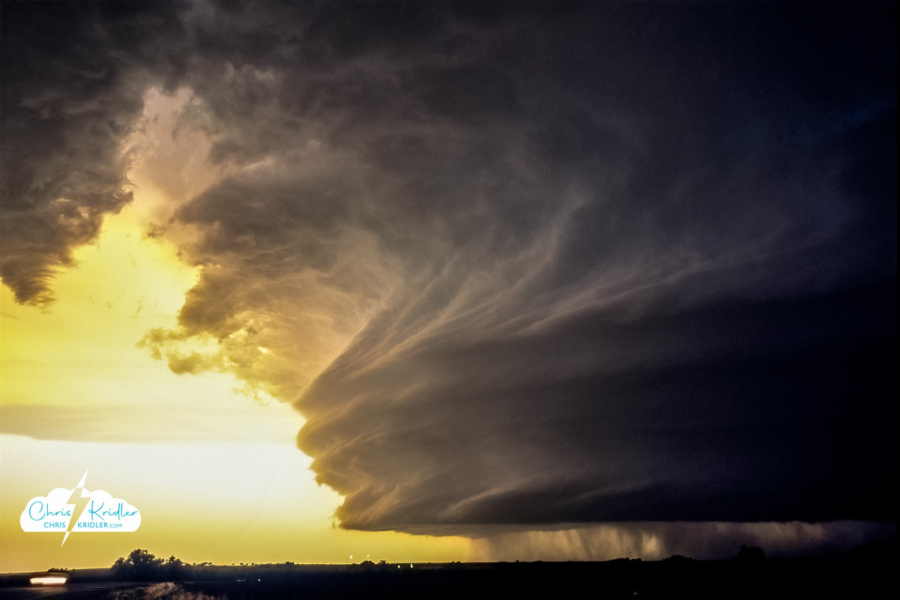
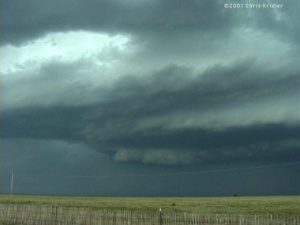
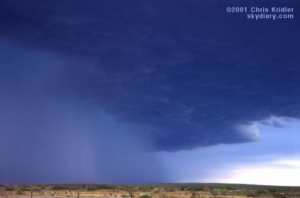
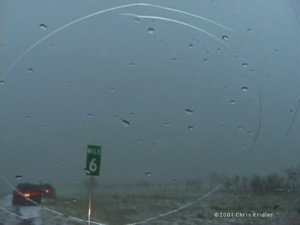
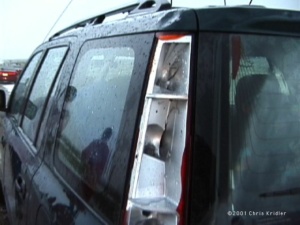
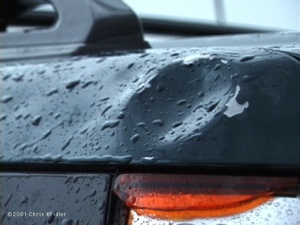
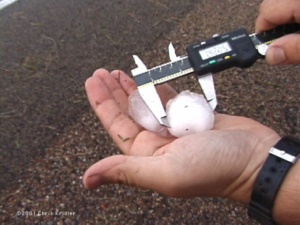
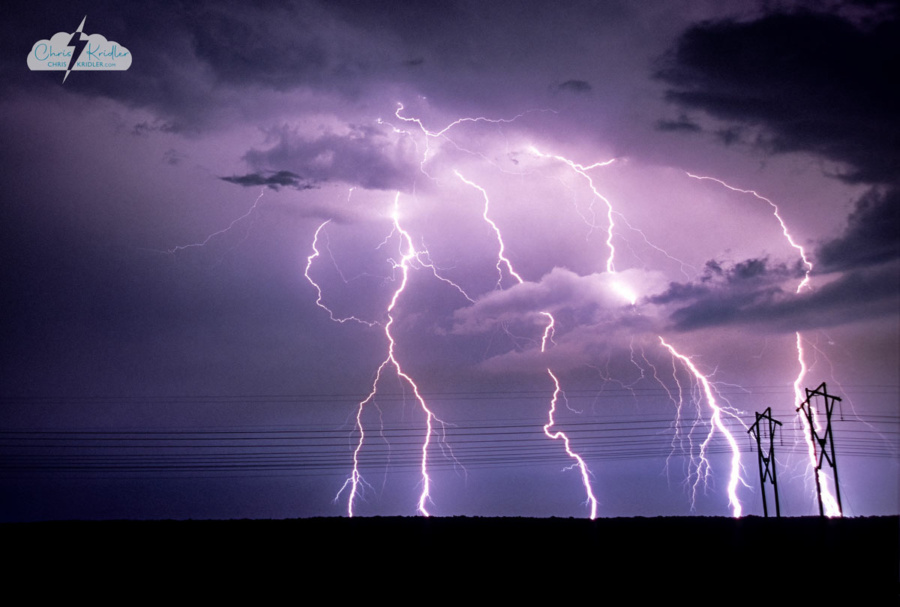
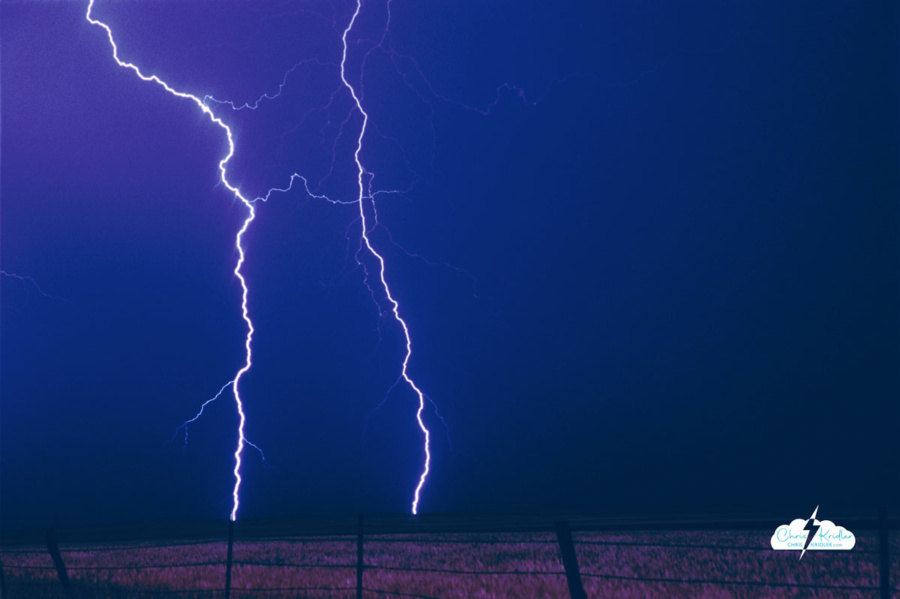
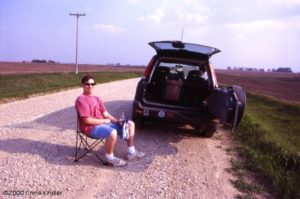 Last Thursday, Dave and I targeted northeast Iowa. Low pressure was moving into the area, which would cause the surface winds to come from the south or southeast, while upper-level winds were streaming in from the west. The result: shear in the atmosphere, meaning if a storm went up — and it was likely where the warm and cold fronts met — it would probably rotate.
Last Thursday, Dave and I targeted northeast Iowa. Low pressure was moving into the area, which would cause the surface winds to come from the south or southeast, while upper-level winds were streaming in from the west. The result: shear in the atmosphere, meaning if a storm went up — and it was likely where the warm and cold fronts met — it would probably rotate.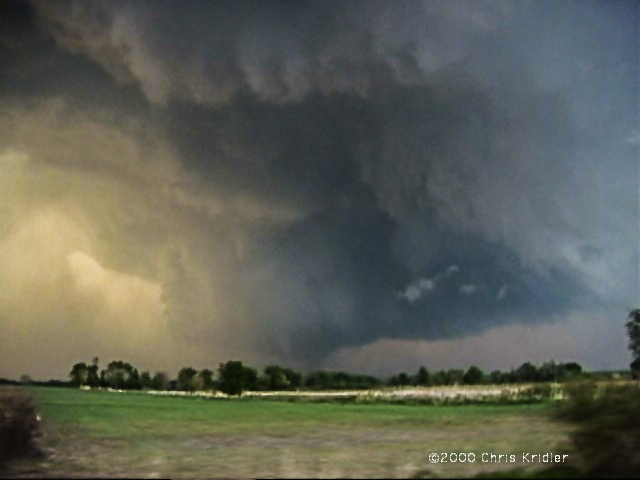
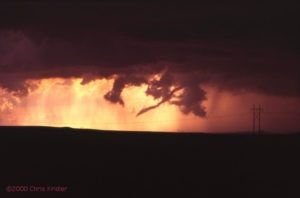 Going backwards in time to May 16 — the day before — we played what seemed iffy chances for supercells in western Nebraska. We thought the action would be in extreme western Nebraska or even eastern Wyoming, especially after checking data and running into chasers Keith Brown and David Fogel (again in Ogallala). As we zoomed west, it became clear that this was going to be a major chaser convergence. Translated: A circus of idiot drivers. Now, obviously, I don’t think all chasers are irresponsible, but there are definitely chasers who are giving the rest of us a bad name. They are also becoming incredibly ostentatious, with loads of silly equipment on their roofs, including (in my opinion) useless marine radar units. What, are they going boating in their Ford Expeditions?
Going backwards in time to May 16 — the day before — we played what seemed iffy chances for supercells in western Nebraska. We thought the action would be in extreme western Nebraska or even eastern Wyoming, especially after checking data and running into chasers Keith Brown and David Fogel (again in Ogallala). As we zoomed west, it became clear that this was going to be a major chaser convergence. Translated: A circus of idiot drivers. Now, obviously, I don’t think all chasers are irresponsible, but there are definitely chasers who are giving the rest of us a bad name. They are also becoming incredibly ostentatious, with loads of silly equipment on their roofs, including (in my opinion) useless marine radar units. What, are they going boating in their Ford Expeditions?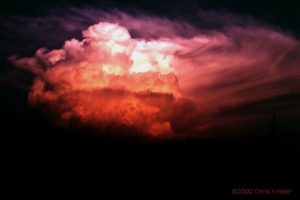 We saw the storm from when it was a pup, a little towering cumulus. It exploded and soon became a big bad dog — isolated. Huge. Multiple overshooting tops. But it was SCREAMING southeast, way ahead of us. It zoomed into Arkansas (Richard left us in mid-chase because of the hopelessness of the pursuit), and we had to listen to hail reports and spotter-reported tornado warning(s) as we tried to pursue it. We ended up in Arkansas, just east of Fort Smith, with a photogenic bomb that formed on its backside — very pretty, though it croaked at sunset. We met David O. Stillings, the Lightning Stalker (that’s just how he introduces himself, too, at rat-a-tat speed) and Jason Persoff, both Florida chasers traveling with a Pioneer Productions TV crew, as well as a couple of Arkansas chasers — Jason Politte and Scott Blair. We’re all part of a strange, little mobile community that keeps meeting on the grassy banks of farm roads in the middle of nowhere.
We saw the storm from when it was a pup, a little towering cumulus. It exploded and soon became a big bad dog — isolated. Huge. Multiple overshooting tops. But it was SCREAMING southeast, way ahead of us. It zoomed into Arkansas (Richard left us in mid-chase because of the hopelessness of the pursuit), and we had to listen to hail reports and spotter-reported tornado warning(s) as we tried to pursue it. We ended up in Arkansas, just east of Fort Smith, with a photogenic bomb that formed on its backside — very pretty, though it croaked at sunset. We met David O. Stillings, the Lightning Stalker (that’s just how he introduces himself, too, at rat-a-tat speed) and Jason Persoff, both Florida chasers traveling with a Pioneer Productions TV crew, as well as a couple of Arkansas chasers — Jason Politte and Scott Blair. We’re all part of a strange, little mobile community that keeps meeting on the grassy banks of farm roads in the middle of nowhere.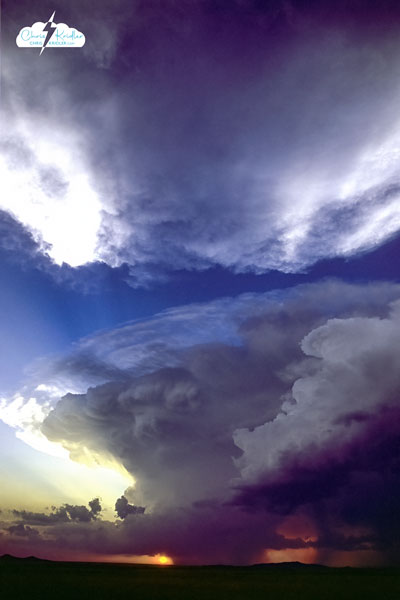
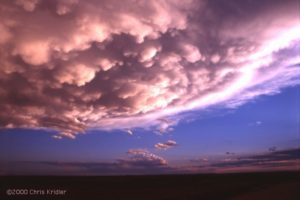
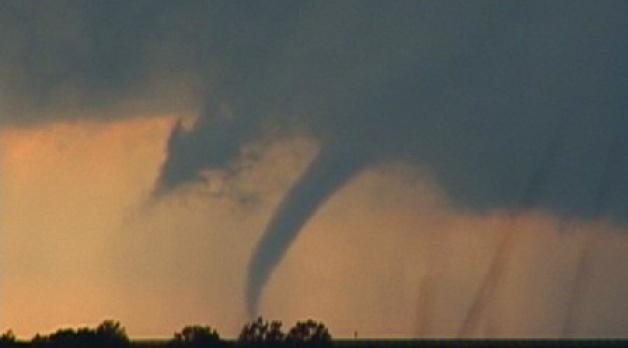
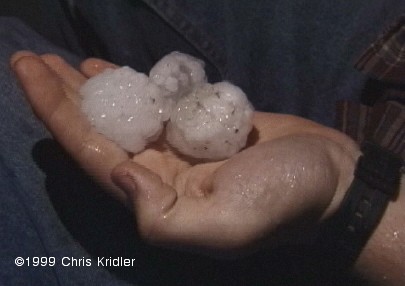
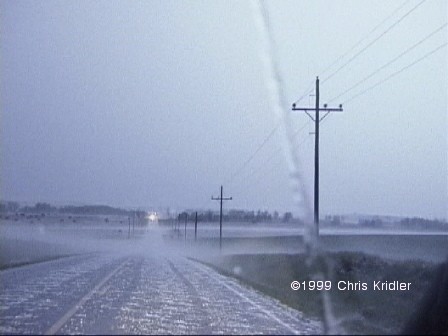

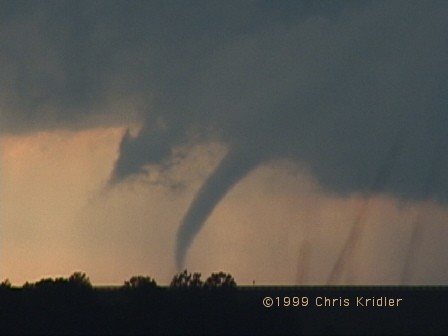
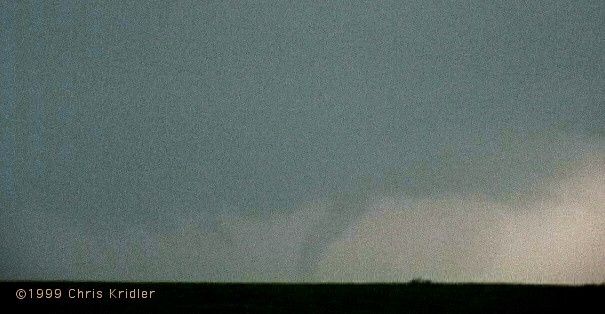
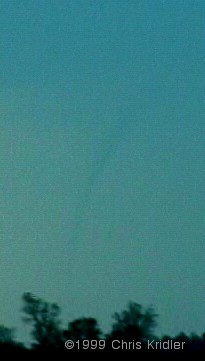
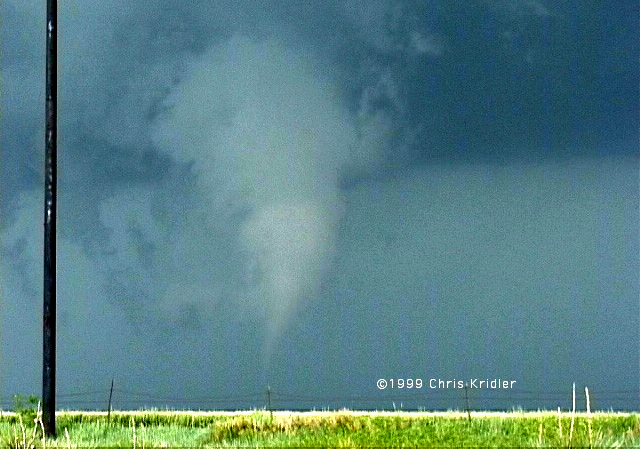
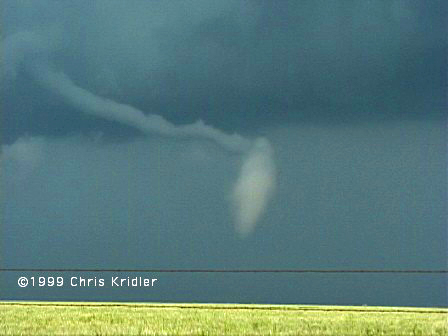
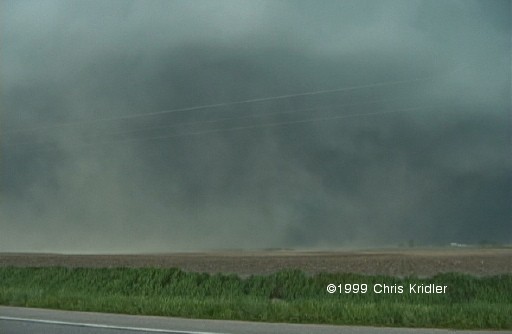
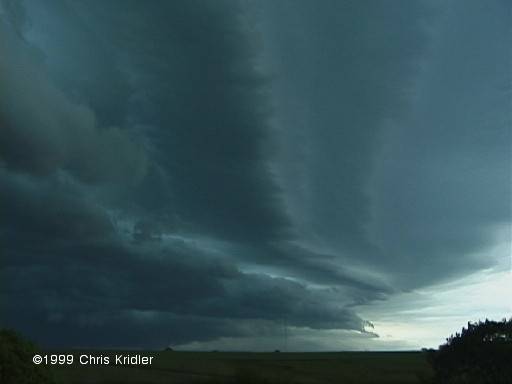
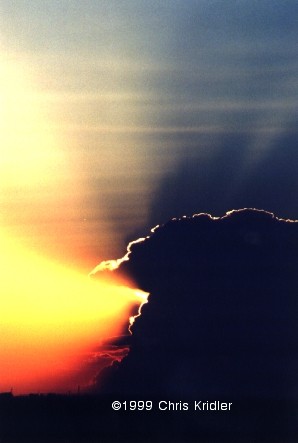
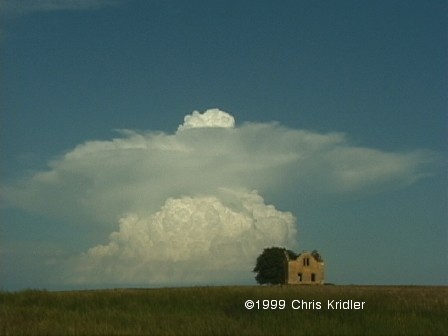

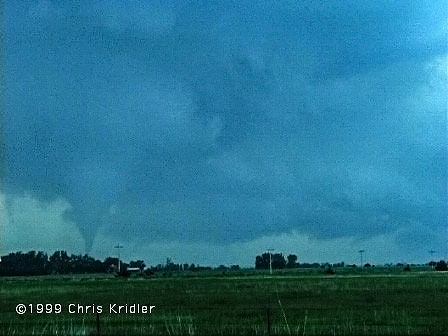
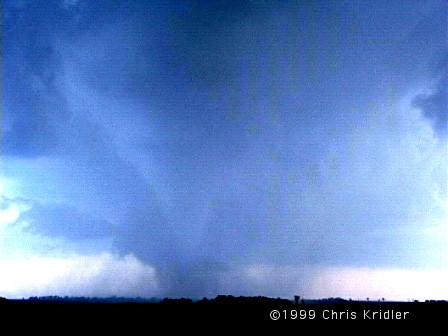
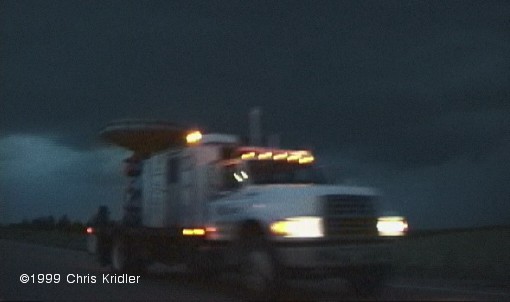
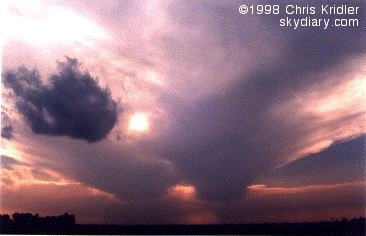 I nearly gave up hope when I saw the tattered remains of a big storm, but I soon realized that several more were building. I headed further west toward one of them, and soon the radio station I was listening to was citing a Doppler-indicated tornado warning. But by the time I got near the storm, the warning had expired. Still, the lightning was amazing, and it was clear that major action was occurring, as I noticed another big “anvil” (blown off the top of a storm) to my south.
I nearly gave up hope when I saw the tattered remains of a big storm, but I soon realized that several more were building. I headed further west toward one of them, and soon the radio station I was listening to was citing a Doppler-indicated tornado warning. But by the time I got near the storm, the warning had expired. Still, the lightning was amazing, and it was clear that major action was occurring, as I noticed another big “anvil” (blown off the top of a storm) to my south.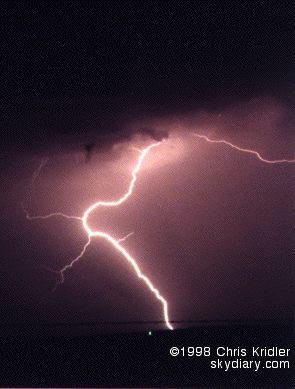
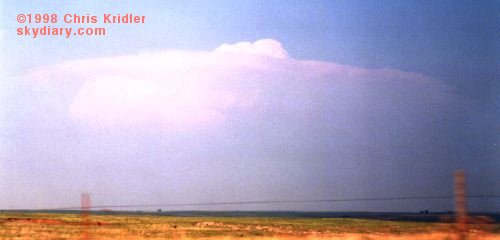 The storm was a loner. That’s an encouraging thing, because no other storms were around to steal its energy (or steal its thunder). It was feeding greedily off the heat and moisture that had been building in the atmosphere and was soon a big fist sticking up. Then it mushroomed, growing in mass and spitting out a big circular anvil at its crest. An overshooting top showed a strong updraft. This was a monster in the making.
The storm was a loner. That’s an encouraging thing, because no other storms were around to steal its energy (or steal its thunder). It was feeding greedily off the heat and moisture that had been building in the atmosphere and was soon a big fist sticking up. Then it mushroomed, growing in mass and spitting out a big circular anvil at its crest. An overshooting top showed a strong updraft. This was a monster in the making.
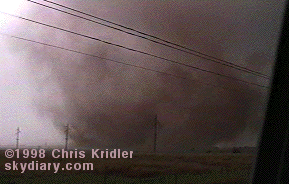 Though it wasn’t particularly strong, it was dramatic — it spun up a big bowl of dust just north of the road and soon was writhing with dark reddish-brown tendrils. It looked as if it was going to cross the road just east of us. Everything was happening very quickly. And then the wind knocked over a telephone pole about 25 yards in front of us and the tornado turned south-southwest — headed right for us. We were in the “bear’s cage.” The other tour van, which was east of the tornado, zoomed east away from the twister as it got within a hundred yards of us, making our big van shudder with strong winds. We got turned around, briefly spun our wheels in the slope off the road and sped west away from it. It was thrilling. It soon crossed the road, weakened and died. Another small tornado spun up south of the road, which was filled with a sudden convergence of storm chasers and cops.
Though it wasn’t particularly strong, it was dramatic — it spun up a big bowl of dust just north of the road and soon was writhing with dark reddish-brown tendrils. It looked as if it was going to cross the road just east of us. Everything was happening very quickly. And then the wind knocked over a telephone pole about 25 yards in front of us and the tornado turned south-southwest — headed right for us. We were in the “bear’s cage.” The other tour van, which was east of the tornado, zoomed east away from the twister as it got within a hundred yards of us, making our big van shudder with strong winds. We got turned around, briefly spun our wheels in the slope off the road and sped west away from it. It was thrilling. It soon crossed the road, weakened and died. Another small tornado spun up south of the road, which was filled with a sudden convergence of storm chasers and cops.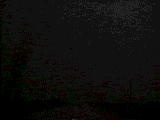
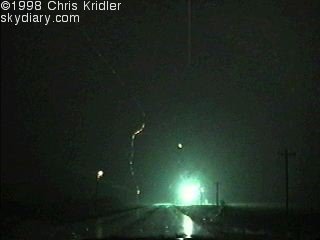

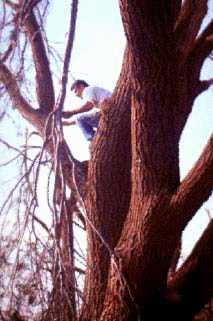
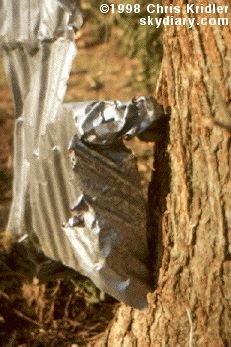 SALINA, Kansas — We’ve had a couple of days of BAD weather. Sunny skies, high heat. There’s a chance of storms today, but based on the data, I’m not getting my hopes up. Still, a couple of days ago, I got to see what the effects of an F3 or F4 tornado are really like.
SALINA, Kansas — We’ve had a couple of days of BAD weather. Sunny skies, high heat. There’s a chance of storms today, but based on the data, I’m not getting my hopes up. Still, a couple of days ago, I got to see what the effects of an F3 or F4 tornado are really like.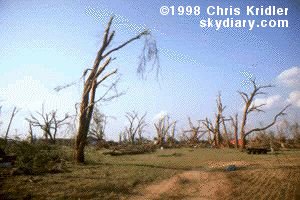 Our group went to Lamont, Oklahoma, where a half-mile-wide tornado — spawned from the same storm that produced the tornadoes we saw — seriously damaged several houses and blasted trees so that they looked as if they’d been through a firestorm. I saw the kind of legendary tornado “tricks” that people talk about — including pieces of hay and corrugated metal shot into trees.
Our group went to Lamont, Oklahoma, where a half-mile-wide tornado — spawned from the same storm that produced the tornadoes we saw — seriously damaged several houses and blasted trees so that they looked as if they’d been through a firestorm. I saw the kind of legendary tornado “tricks” that people talk about — including pieces of hay and corrugated metal shot into trees.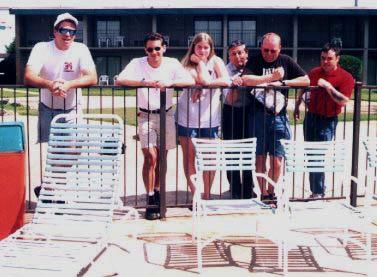
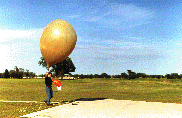 We return to Norman, a southern suburb of OKC, to see the evening launch of a weather balloon at the National Severe Storms Laboratory. Such daily launches provide the lab and its Storm Prediction Center with some of the data needed to predict severe storms.
We return to Norman, a southern suburb of OKC, to see the evening launch of a weather balloon at the National Severe Storms Laboratory. Such daily launches provide the lab and its Storm Prediction Center with some of the data needed to predict severe storms.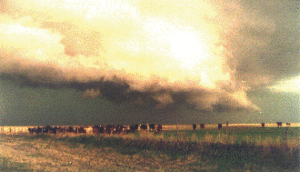 We stop twice in front of what has become a rapidly advancing gust front, a gloomy, undulating line of storm that isn’t likely to produce a tornado but is very likely to spit out hail and rain and fierce winds. It’s on top of us in a just a few minutes each time, sending the cows before it stampeding.
We stop twice in front of what has become a rapidly advancing gust front, a gloomy, undulating line of storm that isn’t likely to produce a tornado but is very likely to spit out hail and rain and fierce winds. It’s on top of us in a just a few minutes each time, sending the cows before it stampeding. It’s Chaser Convergence, a common phenomenon when serious storm-chasers are after the same storm systems. VORTEX goes through. Matt Biddle’s decal-clad El Camino pulls in, though it appears someone else is driving. Marty Feely appears with one of his Whirlwind Tours. Jim Leonard and Casey Crosbie show up.
It’s Chaser Convergence, a common phenomenon when serious storm-chasers are after the same storm systems. VORTEX goes through. Matt Biddle’s decal-clad El Camino pulls in, though it appears someone else is driving. Marty Feely appears with one of his Whirlwind Tours. Jim Leonard and Casey Crosbie show up.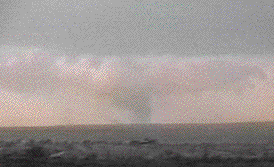 It breaks apart as we stop to watch the advancing storm.
It breaks apart as we stop to watch the advancing storm.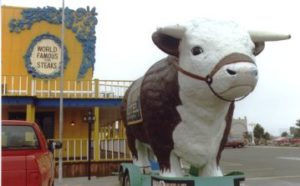 Steve and Charles discuss whether to chase. It’s a “slight risk” day. We decide to give it a shot, but first, a visit to an Amarillo landmark: The Big Texan. A colorful tourist trap, the restaurant-hotel-gift shop complex is designed to look like an Old West town. A elephant-size fake cow guards the front door. A sign tells us that if we can eat a 72-ounce steak in an hour, it’s free!
Steve and Charles discuss whether to chase. It’s a “slight risk” day. We decide to give it a shot, but first, a visit to an Amarillo landmark: The Big Texan. A colorful tourist trap, the restaurant-hotel-gift shop complex is designed to look like an Old West town. A elephant-size fake cow guards the front door. A sign tells us that if we can eat a 72-ounce steak in an hour, it’s free!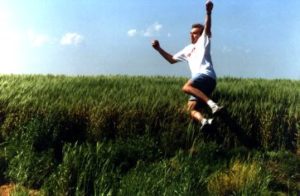 Along a road that looks like Prairie Stop in “North by Northwest,” The Bild reporter tries to melt his ice cream. The Bild photographer snaps pictures. Casey makes phone calls and jumps into a wheat field. Charles plays with his web site and computer games. Steve stares at the sky. Another German journalist, who has joined us for just a couple of days, sits in a dusty gully. I throw a little balsa-wood plane and run to retrieve it, only to screech to a halt in front of an enormous snake. We all gather around. It’s a rattler, all right, but it’s lost its rattle. After some rather foolish teasing by Steve, it slithers off into a wheat field.
Along a road that looks like Prairie Stop in “North by Northwest,” The Bild reporter tries to melt his ice cream. The Bild photographer snaps pictures. Casey makes phone calls and jumps into a wheat field. Charles plays with his web site and computer games. Steve stares at the sky. Another German journalist, who has joined us for just a couple of days, sits in a dusty gully. I throw a little balsa-wood plane and run to retrieve it, only to screech to a halt in front of an enormous snake. We all gather around. It’s a rattler, all right, but it’s lost its rattle. After some rather foolish teasing by Steve, it slithers off into a wheat field.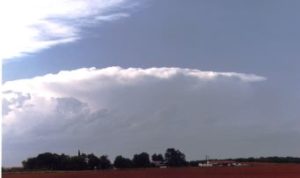 We end up between the storms instead, and they are the most dazzling of the trip. Serendipity guides us. The fabulous sunset sets afire both monster clouds, as rain hangs like feathery mist from their dark bellies. Mammatus clouds glow orange, and lightning forks to the ground and crawls across the sky. A breeze carrying fresh, brisk air whisks through our group. Charles and Lan set up cameras and shout ecstatically when the lightning bolts cooperate with their shutters. I take pictures until I run out of film.
We end up between the storms instead, and they are the most dazzling of the trip. Serendipity guides us. The fabulous sunset sets afire both monster clouds, as rain hangs like feathery mist from their dark bellies. Mammatus clouds glow orange, and lightning forks to the ground and crawls across the sky. A breeze carrying fresh, brisk air whisks through our group. Charles and Lan set up cameras and shout ecstatically when the lightning bolts cooperate with their shutters. I take pictures until I run out of film.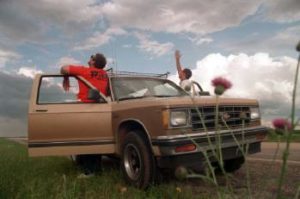 So the next day, Casey takes me and another hanger-on, Allan Rosenberg, storm-chasing. Allan, a lawyer, is the creator of a storm-chasing comic that is only available on the Web.
So the next day, Casey takes me and another hanger-on, Allan Rosenberg, storm-chasing. Allan, a lawyer, is the creator of a storm-chasing comic that is only available on the Web.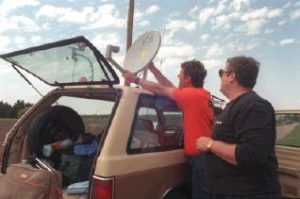 This is how the tour ends, not with a bang, but a whimper. Up into Nebraska we drive, then back down through Kansas, catching some minor storms on the way back to Norman. Charles is frustrated. I’m frustrated. Allan might be frustrated, but he’s not saying.
This is how the tour ends, not with a bang, but a whimper. Up into Nebraska we drive, then back down through Kansas, catching some minor storms on the way back to Norman. Charles is frustrated. I’m frustrated. Allan might be frustrated, but he’s not saying.